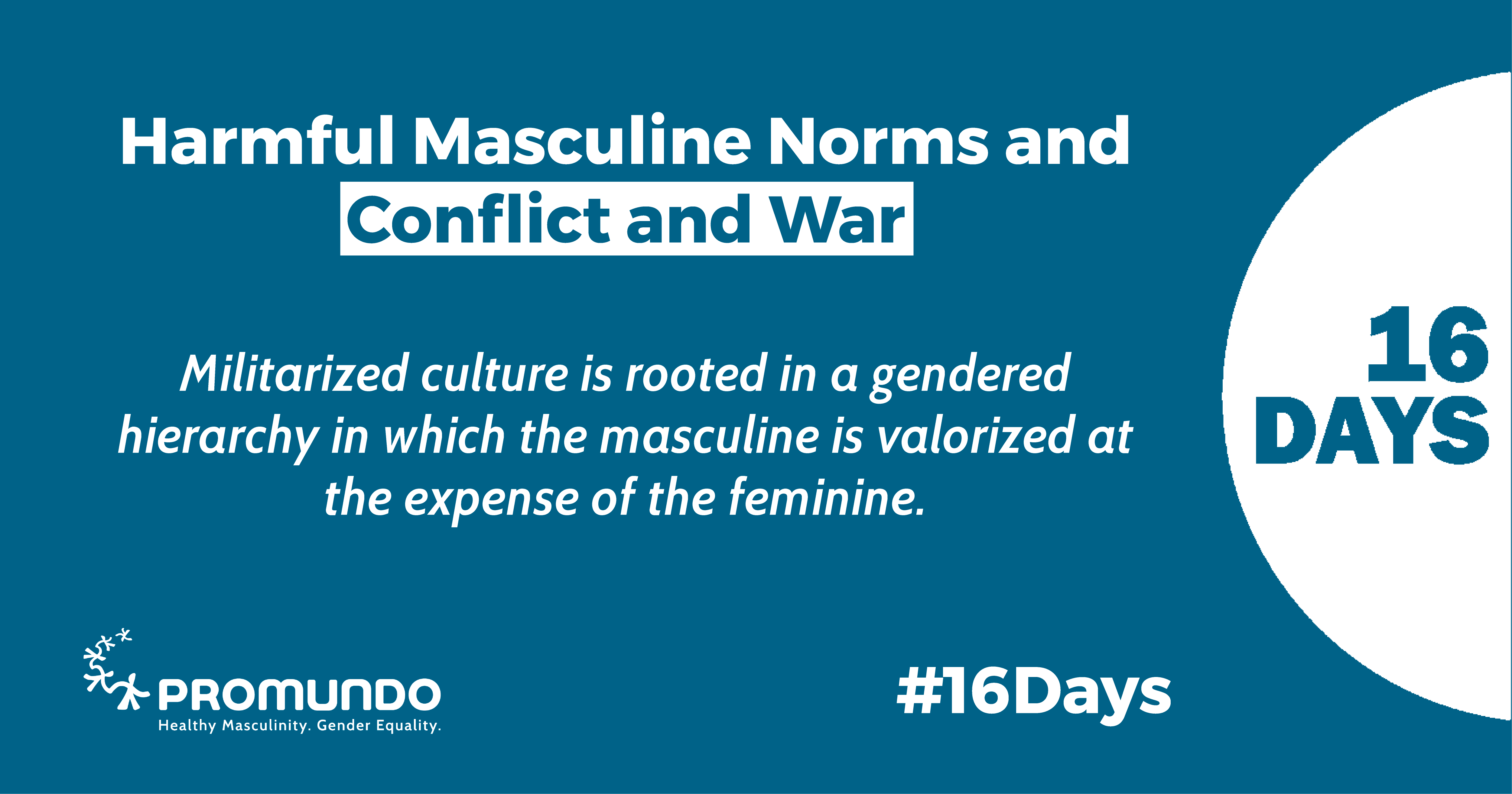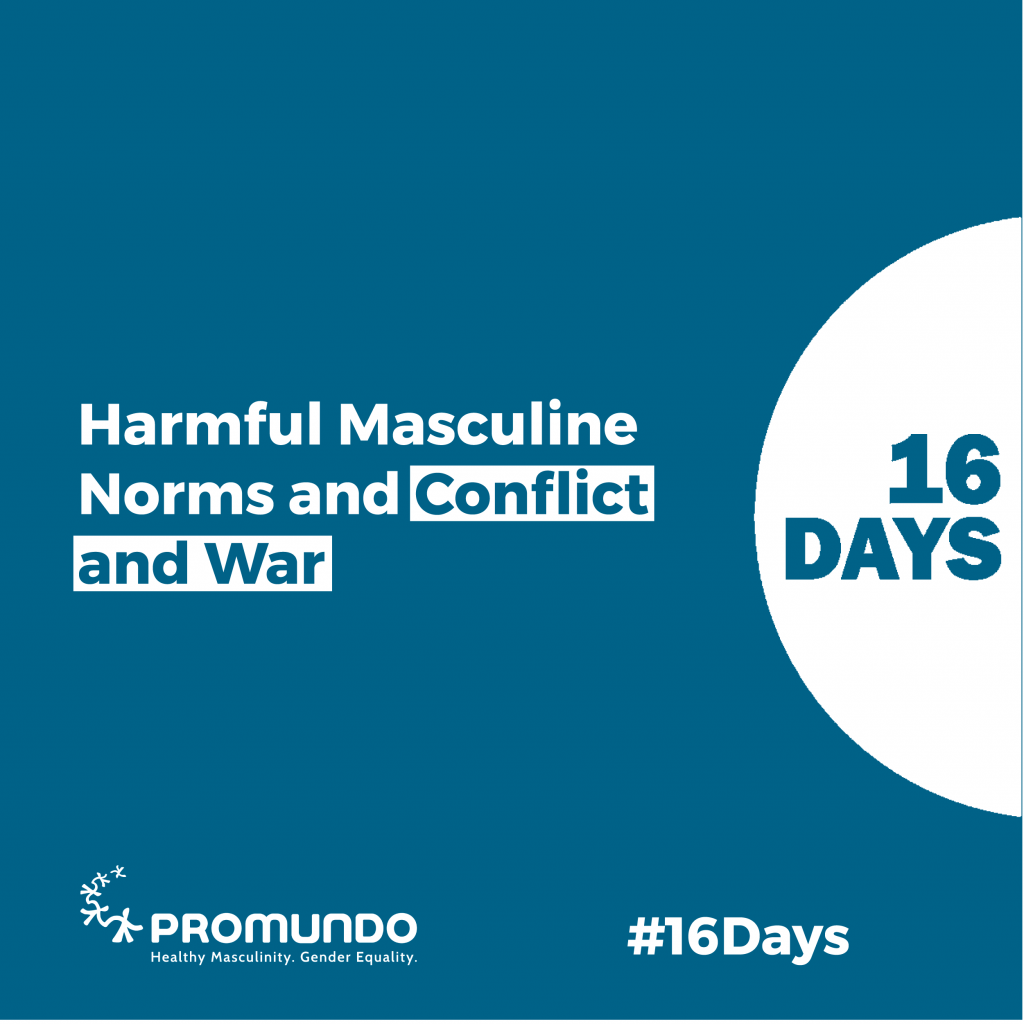The 16 Days of Activism Against Gender-Based Violence is an international campaign used by activists around the world (November 25-December 10) as an organizing strategy to call for the elimination of all forms of gender-based violence.
This year, we will be sharing out research on the links between harmful masculine norms and eight different forms of violent behavior, as well as insights and recommendations to eliminate all forms of violence.

While there is nothing inherent about being male that drives violence, how we socialize boys into their identities as men and what we expect of them – that is, society’s masculine norms – are undeniably linked with violence.
Indeed, boys and men are often raised, socialized, and encouraged to use violence in some form; on the whole, men and boys are disproportionately likely to both perpetrate most forms of violence and to die by homicide and suicide. However, the research affirms that this violence is preventable, gender equality is achievable, and nonviolent norms and ideas about manhood are prevalent and powerful.
Equimundo and Oak Foundation’s report Masculine Norms and Violence: Making the Connections, examines the links between harmful masculine norms and eight forms of violent behavior. This eighth and final blog in the Making the Connections, 16 Days of Activism series focuses on conflict and war. It breaks down the facts on conflict and war, explores their linkages to other forms of violence, and provides recommendations for action.
Conflict and War
The Facts
Men are disproportionately likely to die as a direct result of armed conflict compared with women. These violent deaths are not the only – or even a major proportion of – deaths associated with active conflict, however, and some data suggest that the majority of overall deaths associated with active conflict – when indirect consequences are considered – are women and children.
Involvement in militaries or militias is also undeniably male. Even among men who voluntarily enlist in the military or join a militia or rebel group, a certain amount of coercion rooted in potential access to dominant, powerful, and privileged masculinity is at play.
The Links
Some scholars suggest that young men’s social exclusion, rather than their inherent nature or their number, may lead them to violent behavior.
Violence, conflict, and war are not related only to men or masculinities. Further, these roles must not be mistaken as static. On the contrary, evidence points to women taking on men’s roles during war, including engaging in combat.
Military/militarized culture is rooted in a gendered hierarchy in which the masculine is valued over the feminine. Traditional militarization relies upon aggression and adventurousness being tied up in performances of hegemonic masculinity, equating “being a man” with conquest, defense, and the willingness to kill. In this way, militarization and the social construction of violent masculinities are reinforcing and interdependent processes.
Objectification, dehumanization (including feminization of enemy combatants), and “othering” are central to creating male soldiers willing to kill, and masculine norms have proven to be useful vehicles for achieving this. Colonization and domination of other cultures, and imperialism are seen as justified and even necessary by cultures that create hierarchical identities in which the hegemonic man is on top, positioning non-hegemonic male identities as inferior and in need of being controlled.
Repression of empathy or social connections is also a shared objective of militarization and hegemonic masculinity. Research also shows that conflict-related rape is a result of a specific production of masculinity that is fostered precisely because of its usefulness in political domination.
The Intersections
Many factors contribute to men’s engagement in violent conflict, such as structural, contextual, individual, and psychosocial factors. These include economic frustration (drawing upon the social expectation that men be financial providers), early exposure to violence, traumatic indoctrination, and the numerous ways that militaries are glorified in a given setting.
Lack of employment and social mobility can result in young men joining armed conflicts as a means of obtaining wealth, as rebellion against ruling classes, or as a result of social vulnerability.
From Theory to Practice
It is still rare for peacekeeping and humanitarian operations to incorporate awareness of gender-related issues, let alone gender-transformative approaches. Initiatives aiming to prevent conflict and war should focus on the following transformations of harmful masculine norms:
- Provide male youth with opportunities for nonviolent livelihoods and pathways to social recognition.
- Discuss, model, and encourage nonviolent forms of masculinity that value emotional expression, community building, and humanizing “the other.”
- Engage men and boys – and women and girls and individuals of all gender identities – in discussions about traditional gender norms, violence, and the military as a gendered space.
Read the rest of the Making the Connections, 16 Days of Activism blog series to learn more about intimate partner violence; physical violence against children; child sexual abuse and exploitation; bullying; homicide and violent crime; non-partner sexual violence; and suicide.
